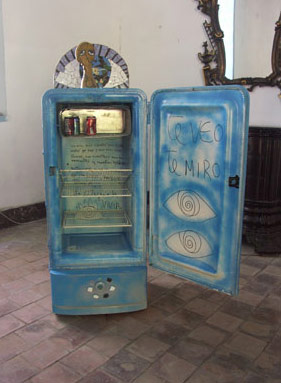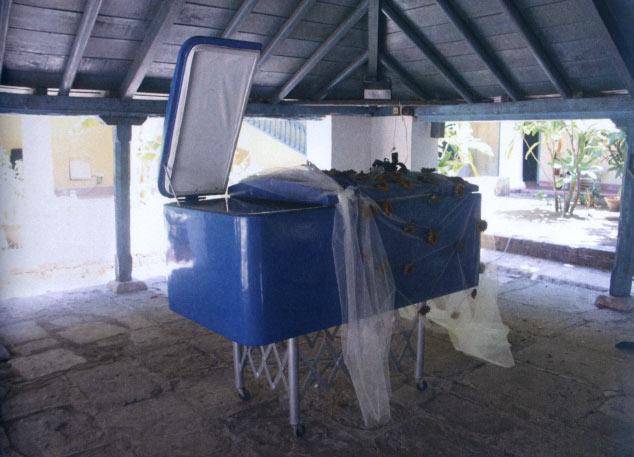Good-by Rocco
Comrades:
Here it lies, against its will, comrade Rocco.
It was born in Detroit in August of 1952, in the General Motors factory.
In its earliest days it witnessed the confron-tations of the trade
unions and the racial vindications that shook its city of birth, thus
forging its unvanquished fighting spirit.
Being still very young, together with its 250
brothers, it is forced to board the overcrowded General Custer - a
cousin of General Motors- steamboat arriving at the bay of Havana
in January of 1953. Here in Havana it is purchased, like ordinary
merchandise, at the store “El Encanto” by the Orozco family,
adopting as of that moment a bourgeois life of abundance during which
it chilled the most exquisite delicacies and liquors. It is not until
five years later, in 1958, when little Joaquin, the youngest child
of the Orozco’s, at the time a Law student at the University
of Havana, begins to hide among champagnes and lobsters subversive
proclamations of the 26 of Julio movement, which causes comrade Rocco
to regain its consciousness and to enter the revolutionary struggle,
going as far as to welcome in the deep of its entrails a comrade of
little Joaquin persecuted by the Tigers of Masferrer.
By 1960, the Survivors of the Orozco family,
(including little Joaquin) leave the country, and the mansion of the
Orozco’s (and, of course, comrade Rocco itself), become property
of the State.
Actively connected to the high-voltage currents
of all the processes of revo-lutionary transformations, comrade Rocco
participates in the Alphabetization Campaign, the Crisis of October
and the Harvest of the 10 Million Tons (working in this more than
365 days per year). During all these years comrade Rocco, far from
longing for the fillets and caviars of its youth, dedicated itself,
with laudable perseverance, to the task of cooling cookies, pastries,
cosmonaut cro-quets (of the kind that stick to the “roof of
the mouth”), refreshments known as “brake liquid”,
and water – plenty of water that quenched the thirst of our
students and militia men.
At the beginning of the 70s, upon the arrival
of his Soviet pairs, comrade Rocco is confined to an honourable “plan
pyjamas”, forgotten in a dark warehouse throughout five grey
years, until the “inventive” administrator of the warehouse
barters it, in a manoeuvre “by the left”, for a set of
twelve chairs to a humble proletarian family, among whose members,
and with its customary disinterested effort and the joy of feeling
useful again, comrade Rocco prepares itself to freeze delicious “durofríos”1,
thus becoming the provider of the family and thereby gaining the affection
of all the children of the district.
The 80s are the years in which comrade Rocco
can live off the fruits of its work. With the earnings from the sale
of those “durofríos”, comrade Rocco is rewarded
with small cream cheeses, plastic ham, garden-style chicken, Bulgarian
wines and an occasional chocolate cake (of the kind that cost 10 Cuban
Pesos ), getting even to cool down for itself a small piece of pork
and a beer in the holidays. And of course, the ever present eggs.
At the beginning of the 90s, and as a result
of the “Special Period”, comrade Rocco is put under the
aggravating system of blackouts that puts it on the brink of a nervous
breakdown. Those blackouts turned out to be so prolonged that when
the electrical current briefly recovered, comrade Rocco came to think
that it was being subject to “electrical shocks”.
It was at those difficult moments that the
humble dwelling of the family who wel-comed comrade Rocco as an ordinary
member, is chosen by the ICAIC2 as the main location for the shooting
of the film “Fresa y Chocolate” in which comrade Rocco,
despite its deteriorated physical and mental health, plays the protagonist
role, with the unanimous acclamation of the public and the critics
as (by far) the best actor of the film.
Far from getting swollen by such an ecu-menical
triumph, comrade Rocco under-takes with renewed determination the
perspectives offered by a new horizon of success: Head of Refrigerators
of the Paladar3 “La Guarida”, because a paladar is what
its house is transformed into as soon as the shooting of the above
men-tioned film is over.
Now, comrade Rocco is again cooling the forgotten
delicacies and liquors of its youth. In this “paladar”,
the charis-matic presence of comrade Rocco is at the focus of attention
of all the clients, getting even to converse with the Queen of Spain,
for whom it produces from its frozen en-trails a local sweet potato
that received the encomiums of His Majesty.
Thus passed the placid old days of com-rade
Rocco, hoping that, as in a dream, natural death would arrive with
that peace of spirit of that which has ful-filled with good conscience
any task ever been entrusted to it.
But no, the death of comrade Rocco arri-ves
in a tragic and sudden way, as it is pub-licly declared an “Energy
Engulfer”.
Its relays and voltage regulators could not
stand the shame, and comrade Rocco explodes in a flaming and fatal
short circuit that sounded in the entire dis-trict like a fateful
PLAFF!
Rocco comrade, wherever you are now, let our
gratefulness and our deepest con-dolences reach out to you for all
your sleepless nights so that once and for all you rest in peace.
Good bye comrade
Good-by Rocco
Adiós
compañero
Good-by Rocco
From
your comrades of the Group ROCINANTE Creation
Jorge
Perugorría
Juan Carlos Tabío



